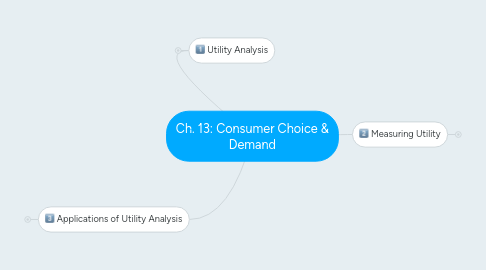
1. Utility Analysis
1.1. Tastes & preferences
1.1.1. Your likes & dislikes in consumption
1.2. The Law of Diminishing Marginal Utility
1.2.1. Total utility
1.2.1.1. is total satisfaction you derive from consumption
1.2.2. Marginal utility
1.2.2.1. change in total utility
1.2.2.2. from a 1 unit change in consumption
1.2.3. Law of Marginal Utility
1.2.3.1. The more of a good a person consumes,
1.2.3.2. the smaller the increase in total utility
2. Applications of Utility Analysis
2.1. Consumer surplus
2.1.1. Difference between the most a consumer would pay and what is actually paid
2.1.2. Marginal valuation
2.1.2.1. $ value of the marginal utility derived from consuming each additional unit of a good
2.1.3. On graph, it is the area under demand curve but above price
2.2. Market demand & consumer surplus
2.2.1. Market demand is the horizontal summation of individual demand curves
2.2.2. Consumer surplus can be illustrated for individuals as well as markets
2.3. Role of time in demand
2.3.1. Consumption has both time and money price
2.3.2. Some people willing to pay more to get things quicker
2.3.2.1. Convenience stores
2.3.2.2. Amazon Prime
3. Measuring Utility
3.1. Units of Utility
3.1.1. Develop numerical values
3.1.2. Each person has a uniquely subjective utility scale
3.2. Maximizing utility without scarcity
3.2.1. If a good is free,
3.2.1.1. you increase consumption as long as marginal utility is positive.
3.3. Maximizing utility with scacity
3.3.1. Must consider:
3.3.1.1. Limited supply
3.3.1.2. Income
3.4. Maximizing conditions
3.5. Relationship with Law of Demand
3.5.1. Can use points at different price levels to construct a demand curve.
